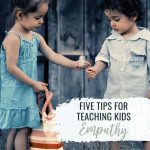It’s hard to feel like you’re winning as a mom; mom guilt is constant, toddlers throw tantrums, life is hard. But one thing that makes most moms feel successful? Seeing their kids exhibit empathy.
Empathy, according to the Oxford English Dictionary, is “the ability to understand and appreciate another person’s feelings, experience, etc.” In short, empathy is the ability to put ourselves in another’s shoes, and it’s actually one of the major social skills we learn and develop in childhood.
Our current historical moment shows that we need empathy now more than ever. We all understand the importance of empathy in child development, but the fact remains: teaching kids empathy is hard!
No worries, mama. We’ve got you covered. These 5 evidence-based activities will help you instill in your children the rich life skill of empathizing with others.
We don’t promise that teaching your children to think of others will be easy, but we do promise that it’s important and fulfilling, and will lead to more healthy relationships as your children age.

This site contains affiliate links, meaning that we earn a small commission for purchases made through our site. We only recommend products we personally use, love, or have thoroughly vetted.
Importance of Empathy In Child Development
According to early learning experts, “In the early years of life, young children are naturally ego-centric and are very much inclined to think mostly about themselves and their immediate needs. They’re not yet ready to consider the needs and feelings of others.”
Nowhere is this more evident than when your toddler has a meltdown at the MOST inopportune time for you possible.
Guess what? Your toddler doesn’t know or care that you have a huge work deadline! He’s simply furious that you changed his wet bed sheets to dry ones when he wanted to sleep on the wet sheets. (How dare you?)
The fact is, negative emotions are natural in young children. They’re natural at any age. People feel when things aren’t going their way, or when others aren’t attune to their wishes, and it hurts.
But as adults, we (usually) know how to handle it. Children need to be taught.
Teaching Children Empathy Is Our Social Responsibility
Young children need to be guided as they learn to think about the needs and perspectives of others, i.e. you’ve got to teach your kid to think about others before himself.
This is where parents, teachers, and anyone who spends time with young children come in.
And we would be remiss if we didn’t say that this process is HARD, y’all.
Teaching your child to value the feelings and needs of others is not an easy task. After all, they were born only thinking of their own most primal needs: eating, pooping, and sleeping.
But we have a social responsibility to others and a personal responsibility to our children to turn their attention away from themselves (once their own needs are met) and to the needs of others.
Ultimately, “developing a sense of empathy is an important developmental process for young children, and one that can benefit them not only in childhood but well into adult life as well” (Goodstart.org).
Ages and Stages of Developing Empathy
So how do kids learn empathy?
As it turns out, it happens in measurable stages, just like everything else in your child’s life. Just like you mark your child’s height on the door frame as she grows, you can also expect her capacity for empathy to expand as she grows.
0-2
Infants and young toddlers largely mimic the emotions of their caregivers. That means you might use careful vocal tone and body language to help a child learn.
According to Scholastic, children learn “to read facial and gestural cues, repeating activities that make people laugh.” This stage is an important precursor to empathy.
3-4
As children develop, so does their ability to understand social and emotional cues. For example, 3-4 year olds can comprehend the connection between emotions and desires.
They can see that, when a peer takes a toy away from another child, that child is sad.
They can see that, when they take a million years to put on their shoes, you become frustrated.
They understand that actions have emotional responses.

5-6
From ages 5-6, children are able to not only empathize with others but are also able to show compassion.
Because empathy develops from self awareness, “as five- and six-year-olds become more aware of their own emotions, they begin to recognize them in others, and their emotional vocabulary expands.”
At this stage, children are able to use all of the skills they have developed (mimicking behavior, understanding the connection between emotions and desires, and exercising compassion) to place themselves in another person’s shoes and choose behavior that supports that person.
As children develop, it’s our job to guide them through these stages.
We can do this in many different ways, but one of the most important ways that you can teach your child empathy is to not be afraid of showing your own emotions and talking about them with your child.
Teaching Kids Empathy: Five Tips
So how can you help guide your child through the stages of learning empathy?
These tips are designed to give you actionable ways to help your child develop empathy skills, no matter which stage of development they’re in.
1. Show emotion
We cannot overemphasize the importance of your example in helping your child learn empathy. It’s important that you not hide your emotions from your child and that you explain these emotions.
Of course, we’re not advocating that you let your child see you in blind rage or in the middle of a full-scale emotional meltdown; you’ll need to decide what’s appropriate for your child to see. But it is crucial that you show and explain appropriate emotion.
For example, if you’re stuck in traffic, try to use it as a teaching moment.
When your three year old asks why you’ve just slammed your hand on the steering wheel, take a moment to explain your frustration and name it as healthy. Ask them about a time when they felt frustrated and how they dealt with it.
2. Lead by example (modeling)
As with most things, kids learn directly from your example. When you have the opportunity to show empathy, include your children in the process. For example, if your partner is running late for work and needs help getting out the door, involve your kids.
Ask them to help you pack lunch for their parent; find her keys; etc. Once you have completed these tasks, take a moment or two to walk your child through why you helped.
This will help them understand that, when others are in need, empathy requires service.
3. Encourage tolerance and acceptance
Children are, by nature, incredibly curious, so when someone or something is different than what they know, they often call it out.
Take these moments to explain that difference is a good thing.
For example, if your child notices that a man is wearing a dress, or that a woman has a large number of colorful tattoos, use this as a teaching example. Often, children point out difference and we shush them.
Instead, use this time to show your child that there are many ways of being in the world and that no one way is the right way.
Teaching your child that humanity is beautiful in all its various forms helps show your child that they are part of the spectrum of beauty and that beauty has more than one form.
4. Involve your children in activities that show care for others–humans and animals, alike
Remember when we said that kids often don’t have the developmental growth necessary to help them see the world outside of themselves?
Actively caring for others is a great way to help them see that there is a world outside of their tiny universe.
Some ways to do this include:
- Making care packages for the homeless, so that when you pass a homeless person at an intersection, you can stop and deliver it
- Including your child in caring for your pets. Make it their daily chore to feed the dog every morning, or if they are old enough, to walk the dog
- Making cards/coloring pictures for folks at the nursing home or friends and family who are sick
5. Develop your child’s emotional vocabulary
When your child is hungry, sick, angry, frustrated, sad, happy, talk about it. Say things like: “you seem to be really upset right now. Can you think of a reason you might feel this way?”
Talking through emotions gives the child the vocabulary to articulate why he might be feeling this way, but it also shows him that it is okay and actually important to talk about feelings.
Often, as parents, we are dismissive of our child’s feelings because it’s easier (no judgement here–it’s way easier to dismiss crying than to figure out its cause!).
But when we take the time to talk through feelings with our children, we enforce the language of emotion and show them that we all have emotions, problems, and need help sometimes.
Want some help with this hard part? We love Daniel Tiger for helping young children name their emotions, and learn how to deal with them. There are episodes for all types of emotions, most of which contain coping mechanisms.
Then, you can ask your child how they’re feeling and they can tell you:
“happy,” “mad,” “sad,” “frustrated,” “left out,” or whatever the case may be.
Teaching Kids Empathy Activities
When teaching empathy to kids, one of the most important things to remember is the fact that their learning shouldn’t be overt or didactic. In other words, you don’t have to plan out empathy lessons during your day.
There’s never a great time to sit down for an empathy lesson.
Children learn by seeing, practicing, and having lessons integrated into their daily activities.
Keep the “lessons” casual.
- Watch TV shows that model empathy, then talk about them & ask them questions
- Read children’s books that celebrate diversity, kindness, and inclusion. Then talk about them!
- Tell them you’re sorry when you make a mistake, then say it’s okay to make mistakes
- Practice discussing emotions with your partner. (e.g. “I’m sorry I just bumped into you, Daddy.” “That’s okay, Mom. It was an accident, and I forgive you.”
- Make an art project out of drawing emojis, and ask your child to identify each emotion.
- When reading a book, pause and ask, “How does Little Blue Truck feel right now?”
- Play with feelings flashcards
While developing empathy in your children is crucial, it’s doesn’t have to be difficult or time-consuming.
When you incorporate empathy into your daily life or use fun games, it will begin to come naturally for all of you.
How do you practice teaching kids empathy in your home?













